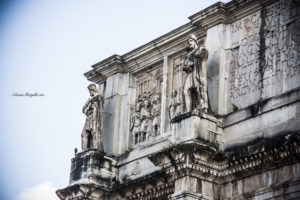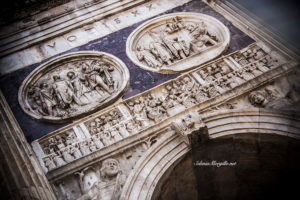The Arch of Constantine
The Arch of Constantine with its 25 meters in height is the largest of the three surviving arches in Rome.
Formed by three arches, made entirely of marble, it is located along the ancient Via Dei Trionfi, in the stretch between the Circus Maximus and the Colosseum.
The inscription placed above the central archway indicates that the arch was solemnly “Dedicated” by the Senate to the emperor in memory of triumph over Maxentius in the Battle of Ponte Milvio (312 AD) and the decades of his reign (25 July 315 AD).
The period of the construction of the arch coincides with the decline of Rome and the beginning of the recycling/spying of all the materials present in the city. In this perspective, the monument turns out to be a set of sculptures and architectural parts from pre-existing buildings.
In detail: the 8 Dacian prisoners placed in the attic come from the Trajan’s Forum. The panels placed between them most likely date from an honorary arch raised by Commodus in memory of his father Marcus Aurelius. The “tondi” (round part) of the second register are from the period of Emperor Adrian ( II century AD).
The remaining part of the decoration is contemporary, however, to the construction of the arch.
The previous and subsequent moments of the Battle of Ponte Milvio are described: the departure for Milan, the siege of Verona, the defeat of Maxentius, the triumphal entry of Constantine into Rome, the speech in the Roman Forum.
In the mid-twelfth century, the monument was included in the Frangipane fortress and over the centuries it has undergone several restorations; the major ones, reintegrating the missing parts, took place in 1733.
A few meters away from the Arch of Constantine, in the Valley of the Roman Forum, the Arch of Septimius Severus!
Info: Reachable by Metro B, Colosseo or Circo Massimo stop
All rights reserved*
L’Arco di Costantino con i suoi 25 metri di altezza è il più grandioso dei tre archi superstiti a Roma.
A tre fornici, realizzato completamente in marmo è posto lungo l’antica via dei trionfi, nel tratto compreso tra il Circo Massimo e il Colosseo.
Celebra la potenza dell’Imperatore Costantino a seguito del suo trionfo su Massenzio, avvenuto il 28 Ottobre del 312 d.C. nella Battaglia di Ponte Milvio.
L’iscrizione posta al di sopra del fornice centrale indica che l’arco fu solennemente “Dedicato” dal Senato all’imperatore in memoria di quel trionfo e dei decennalia del suo regno (25 Luglio 315 d.C.).
Il periodo della realizzazione dell’arco coincide con il declino di Roma e l’inizio del riciclio/spolio di tutti i materiali presenti in città. In questa ottica il monumento risulta essere un insieme di sculture e parti architettoniche provenienti da edifici preesistenti.
Nel dettaglio: gli 8 prigionieri daci posti nell’attico provengono dal Foro di Traiano. I pannelli ad essi interposti risalgono molto probabilmente ad un arco onorario innalzato da Commodo in memoria del padre Marco Aurelio. I “tondi” del secondo registro sono dell’epoca Adrianea.
La restante parte della decorazione è contemporanea, invece, alla costruzione dell’arco. Sono descritti gli attimi precedenti e successivi della Battaglia di Ponte Milvio: la partenza per Milano, l’assedio di Verona, la sconfitta di Massenzio, l’ingresso trionfale di Costantino a Roma, il discorso nel Foro Romano.
A metà del XII secolo, il monumento fu incluso nella fortezza dei Frangipane e nel corso dei secoli è stato sottoposto a diversi restauri; i maggiori, di reintegrazione delle parti mancanti, sono avvenuti nel 1733.
A pochi metri di distanza dall’Arco di Costantino, nella Valle del Foro Romano è visibile anche l’arco di Settimio Severo!
Info: Raggiungibile con la Metro B, fermata Colosseo o Circo Massimo
Sostieni la #culturachevince, aiuta la condivisione!


One Reply to “The Arch of Constantine”
Opera d’arte e di storia